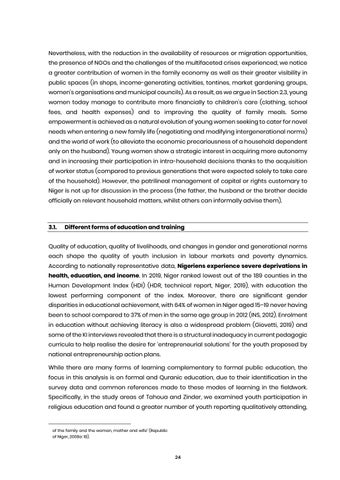Nevertheless, with the reduction in the availability of resources or migration opportunities, the presence of NGOs and the challenges of the multifaceted crises experienced, we notice a greater contribution of women in the family economy as well as their greater visibility in public spaces (in shops, income-generating activities, tontines, market gardening groups, women's organisations and municipal councils). As a result, as we argue in Section 2.3, young women today manage to contribute more financially to children’s care (clothing, school fees, and health expenses) and to improving the quality of family meals. Some empowerment is achieved as a natural evolution of young women seeking to cater for novel needs when entering a new family life (negotiating and modifying intergenerational norms) and the world of work (to alleviate the economic precariousness of a household dependent only on the husband). Young women show a strategic interest in acquiring more autonomy and in increasing their participation in intra-household decisions thanks to the acquisition of worker status (compared to previous generations that were expected solely to take care of the household). However, the patrilineal management of capital or rights customary to Niger is not up for discussion in the process (the father, the husband or the brother decide officially on relevant household matters, whilst others can informally advise them).
3.1.
Different forms of education and training
Quality of education, quality of livelihoods, and changes in gender and generational norms each shape the quality of youth inclusion in labour markets and poverty dynamics. According to nationally representative data, Nigeriens experience severe deprivations in health, education, and income. In 2019, Niger ranked lowest out of the 189 counties in the Human Development Index (HDI) (HDR, technical report, Niger, 2019), with education the lowest performing component of the index. Moreover, there are significant gender disparities in educational achievement, with 64% of women in Niger aged 15–19 never having been to school compared to 37% of men in the same age group in 2012 (INS, 2012). Enrolment in education without achieving literacy is also a widespread problem (Giovetti, 2019) and some of the KI interviews revealed that there is a structural inadequacy in current pedagogic curricula to help realise the desire for ‘entrepreneurial solutions’ for the youth proposed by national entrepreneurship action plans. While there are many forms of learning complementary to formal public education, the focus in this analysis is on formal and Quranic education, due to their identification in the survey data and common references made to these modes of learning in the fieldwork. Specifically, in the study areas of Tahoua and Zinder, we examined youth participation in religious education and found a greater number of youth reporting qualitatively attending,
of the family and the woman, mother and wife’ (Republic of Niger, 2008a: 18).
24
